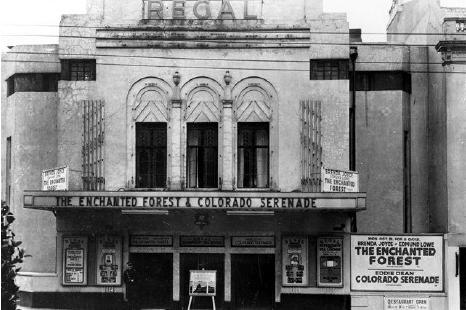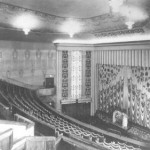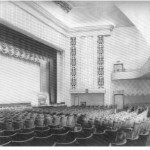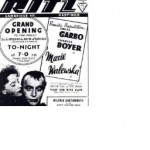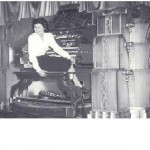The Melody Lingers on Don Valentine remembering the sound of LOCAL THEATRE ORGANS – PAST & PRESENT
Whenever I hear the strains of Ravels BOLERO , I am seated in the Circle of the Regal Super Cinema taken there by a visiting aunt to see “Bolero” starring amongst others George Raft, Carole Lombard and Ray Milland. If you recognise these names, stay aboard for a journey into nostalgia……………………
It wasn’t the film that I particularly remember, more what happened at the end of it. Suddenly the whole theatre was filled with a wonderful sound, and the spotlights led to this seemingly small man playing the keys of this mighty instrument. Both he and the keyboards seemed “sandwiched” between two large book-ends! The magic of the moment was that this had all risen out of the floor of the orchestra pit on a platform centre stage.
I could not wait to tell my Mum all about it on my return home in Hollington! I think this was my only visit to the Regal before World War II as my family moved to Halton, and the Cinema De Luxe was the favoured venue for seeing the antics of The Crazy Gang and several comedy films starring George Formby.
Soon after war was declared, the Regal, which had only opened 8 years earlier, was closed for the duration of the war. 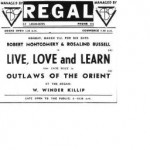
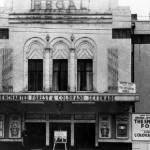
It is worth noting that the organ of three manuals and six ranks of pipes was installed by the John Compton Organ Company. The first long-stay resident organist was Gerald Shaw, then a schoolteacher at a boy’s residential school in Hollington Park Road. Gerald was a very talented musician, and ascended the ladder, which saw him as resident at Odeon’s “Queen” Theatre in London’s Leicester Square where he remained until his death in the 1970’s.
The Regal Super Cinema (its correct name on opening in 1932) was a unique building, sited on a steep slope downwards from the main road, but advantage was taken of this by building the circle level with the main entrance doors, with steps leading further down to the stalls. It could accommodate 1600 people. Green and silver was the colour scheme, and daylight penetrated the auditorium through a glass dome fitted in the balcony ceiling. It is believed that the Regal was one of the first cinemas in the UK to be fitted with a loop hearing system for the deaf.
Following a massive spring clean the theatre re-opened in 1946. Stage shows ran for the high season, and films for the winter. By then the surround of the organ console was illuminated in a “jelly mould” design for many of the ABC theatres.
Throughout the 18 years that the Regal was open it never made a profit, and a decision was taken in September 1956 to close the theatre. Almost immediately work started to dismantle the building and its contents. The Compton organ was removed from the cinema, broken up and various parts sold on individually. In the roof, however, was the blower motor which powered the air supply for the organ’s many pipes, and this Page Thirteen was found to be in relatively good working order, and found its way along the coast for extended service at Rye.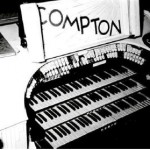
RITZ CINEMA
On Saturday 19th March 1938, the Mayor Alderman Ford congratulated ABC Ltd on “ an entertainment hall of such magnificence and enterprise” as he declared open the RITZ CINEMA. The invited audience saw the British Premiere of the Greta Garbo film, “Marie Waleswska”, which co-starred Charles Boyer, Alan Marshall and Dame May Whitty.
In the Ritz Café one could choose morning coffee, light and full lunches and afternoon full cream teas.
The auditorium could accommodate nearly 2,000 people. The Wurlitzer organ of three manuals and eight ranks had been imported direct from the Wurlitzer factory in North Tonawanda, USA. It had an elaborate illuminated surround, and I can still recall it rise in 1939 bearing an array of soft toys advertising the next week’s presentation of “The Wizard of Oz”. The cinema remained open during the war years.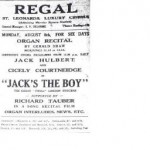
Other than a capable young man, Eric Easton, I cannot recall the names of any resident organists, though visiting celebrities sometimes stayed more than a week before travelling onto their next engagement. One I especially remember was the late Andrew Fenner, who had conducted tours through the pit and pipes during some mornings during Carnival Week.
During the 1950’s “organ interludes” between films occurred less often, and, as with many other cinemas in the U.K., their organs became redundant, and were put up for sale, and the Hastings instrument was sold to a private buyer in 1965. With the organ gone, the stage was extended and hosted stars like Cliff Richard, The Shadows, Billy Fury and Mark Wynter. The Ritz did, however, have one notable long-runner – the ABC Minors who flocked to the cinema for 25 years between 1946 and 1971. The cinema closed in 1971.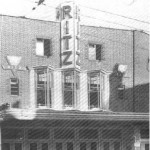
RYE COLLEGE (FORMERLY THOMAS PEACOCKE COMMUNITY COLLEGE).
During the 1950’s the school Head of Music William May wanted a real pipe organ to be installed. He negotiated the purchase of a two manual five rank Wurlitzer which had become redundant at the Palace Cinema in Tottenham, North London ( where it had been in residence since imported from the USA in 1925 – one of a pair and now the second oldest in the country).
At Rye the organ was used for school assemblies, but over a period of time and with little regular maintenance its condition deteriorated and by the 70’s it was Page Fourteen hardly ever heard if at all by the students.
In the 1980’s a new Head of Chemistry was appointed at the school, who also had an FRCO qualification after his name, Nigel Spooner. At about the same time Nigel became organist at All saints Church Hastings where he inaugurated a summer series of concerts on the Father Willis Organ which still continue to be well attended some 20 years later. Nigel naturally became int e r e s t e d in t he School’s poorly Wurlitzer, and he started what was to become a restoration process. Soon after he left on promotion and there was interested for the instrument to be sold to a private collection in Cornwall.
Former head boy Richard Moore stepped in and took a keen interest in the organs renovation, and in 1993 put his full weight into making his dream come true. The major project was to move the instrument from the balcony to a lift below the stage, and this was finally achieved in 2007 . He has been responsible for close on 200 fund raising events, as well as founding a “supporters club” known as the FRIENDS OF RYE WURLITZER.
In 2008 Friends of Rye Wurlitzer became a registered charity, so that all taxpayers giving donations mat allow the charity to reclaim a further 28% – a most valuable source of income.
In early 2009 FORW were awarded three thousand five hundred pounds by the Grass Roots Foundation for the installation of a new audio visual system. This will enable the audience to see on a large screen close ups of the performers hands and feet as well as the moving parts in the organ chamber – all at the same time.
A Wurlitzer Gala day is scheduled for September 27th this year feature internationally renowned organist LEN RAWLE, who has been a great supporter and guide to the technical team at Rye from day one. Without him the RYE WURLITZER would not be the success story which it enjoys today. Who know – one day I may hear the strains of BOLERO again with wind from the same blower as in 1934.
If you would like to know more about the Friends of Rye Wurlitzer then a visit to their website is very worthwhile. www.geocities.com/ryewurlitzer or even better turn up at one of their forthcoming concerts. Should you wish to find out more visit their website or contact Chairman Richard Moore (01424) 444058 or email [email protected]
First printed in the April 2009 issue of “Hastings Town”
From the November 2012
All articles, photographs and drawings on this web site are World Copyright Protected. No reproduction for publication without prior arrangement. © World Copyright 2016 Cinque Ports Magazines Rye Ltd., Guinea Hall Lodge Sellindge TN25 6EG
